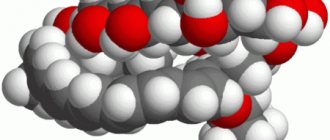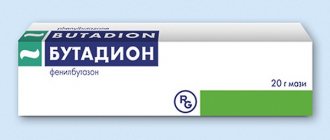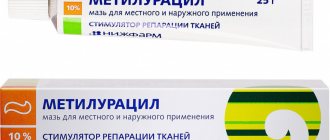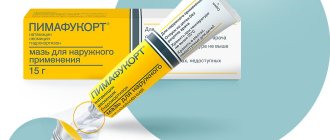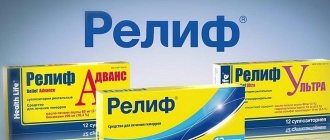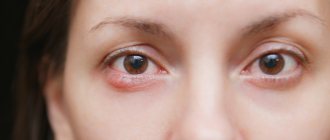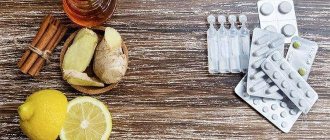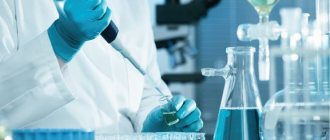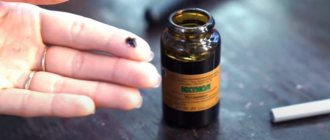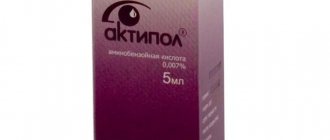Nosological classification (ICD-10)
- L02 Skin abscess, boil and carbuncle
- L08.0 Pyoderma
- L98.4.2* Trophic skin ulcer
- L98.9 Lesions of skin and subcutaneous tissue, unspecified
- M13.9 Arthritis, unspecified
- M19.9 Arthrosis, unspecified
- M25.5 Joint pain
- M42.9 Spinal osteochondrosis, unspecified
- M60 Myositis
- M79.1 Myalgia
- M79.2 Neuralgia and neuritis, unspecified
- T14.0 Superficial injury to unspecified body area
- T14.1 Open wound of unspecified body area
- T14.2 Fracture in an unspecified area of the body
- T14.3 Dislocation, sprain and damage to the capsular-ligamentous apparatus of a joint of an unspecified area of the body
Side effects
Overdose
Excessive use of ointment can lead to local allergic reactions (redness, itching, burning). As a rule, these manifestations go away if you start using an ointment with a lower content of pine resin or stop the drug altogether.
If the allergic reaction is severe and a large area of skin is affected, you can treat the site of the allergy with a 40% ethanol solution to soften the reaction. To properly eliminate the consequences of an overdose, you should consult a specialist.
Contraindications
Did you know that...
Next fact
The only contraindication to the use of the ointment is intolerance to pine oleoresin. The drug is not prescribed if the patient has an individual intolerance to pine oleoresin or the excipients of the ointment.
If an allergic reaction occurs after starting to use the drug, it is discontinued or the percentage of resin in the ointment is reduced.
Biopin is used only on shallow wounds without heavy bleeding.
If constant pain occurs during treatment, treatment is stopped or the ointment is replaced with a less concentrated one.
During pregnancy and lactation
No studies have been conducted on the effect of the ointment on the fetus: the drug is practically not absorbed into the blood due to its exclusively external use. When breastfeeding, it is necessary to protect the baby from swallowing the ointment. .
Directions for use and doses
Externally, in the form of 5, 10 and 20% ointment.
For the treatment of long-term non-healing wounds, trophic ulcers, bedsores, 5% ointment is used; for the treatment of wounds and purulent-inflammatory diseases of the skin and subcutaneous tissue - 10% ointment; for the treatment of inflammatory and post-traumatic diseases of the musculoskeletal system and peripheral nervous system - 20% ointment.
Apply a thin layer (approximately 1 mm thick) onto a thick cotton cloth, which is placed on the affected area. If the wound is localized in a place that is inconvenient for bandaging, it is permissible to use an adhesive bandage or adhesive bandage. When treating wounds, the ointment layer should exceed the circumference of the wound by at least 0.5 cm. The dressing is changed 2 times a day. If the dressing is heavily soaked with wound contents, the dressing is changed as it becomes soaked, but not earlier than after 2 hours.
Used on shallow wounds with good outflow of wound exudate.
The daily dose of ointment depends on the area of the affected area and is 2–5 g.
Treatment is continued until signs of inflammation and epithelization of the skin disappear permanently. If necessary, the course of treatment is repeated.
If a persistent pain reaction or burning occurs, use an ointment of a lower concentration.
Instructions for use
pharmachologic effect
Biopin belongs to the group of antiseptics , is an effective remedy against inflammation, kills microbes, promotes wound healing and the rejection of dead cells, and increases the overall level of immunity.
In addition, the drug is active against gram-positive (Staphylococcus aureus, Streptococcus pyogenes) and gram-negative (Escherichia coli, Pseudomonas aeruginosa) bacteria . Moderately active as an antifungal agent.
The mechanism of action of the drug is associated with an increase in the efficiency of the cell's antioxidant system, an increase in the activity of low-molecular components of this system, an increase in the number of phagocytes (immune system cells that protect the body by absorbing harmful particles or dead cells), and suppression of fatty acid oxidation processes. In addition, the activity of neutrophils (a type of leukocyte that is also responsible for the immune response to the inflammatory process) increases.
Release form, composition
Biopin is available in the form of an ointment for external use. Sold in dark glass jars, plastic jars, tubes of 30, 40 or 50 grams. The content of pine resin in the medicine can be 5%, 10% or 20% . Excipients of Biopin are beeswax, rendered pork fat (edible), refined olive oil.
The ointment comes in three types with different dosages: 5%, 10% and 20%
Indications for use
Biopin is available in three different concentrations, and the indications for use of the three versions of the drug are different..
An ointment containing 5% pine resin is prescribed for treatment:
- long-term non-healing wounds;
- complications of the wound to a trophic ulcer (a weeping purulent wound that may not heal for years);
- bedsores (death of soft tissue due to prolonged pressure).
An ointment with 10% active substance is prescribed for purulent-inflammatory diseases of the skin and subcutaneous tissue (furunculosis - inflammation of the hair follicles and sebaceous glands, pyoderma - infection of wounds by pyogenic bacteria, and others).
Biopin 20% is used for the treatment of inflammatory and post-traumatic diseases of the musculoskeletal and peripheral nervous systems:
- arthritis and arthralgia (corresponding joint pain syndrome);
- osteoarthritis (internal damage to the joint), osteochondrosis (disease of the cartilaginous surfaces of bones);
- myositis (inflammation of muscle tissue) and myalgia (muscle pain syndrome);
- various forms of neuralgia;
- bruises and ligament damage;
- closed bone fractures.
20% Biopin is used to treat arthritis and other joint diseases.
Directions for use, dosage
All types of ointment are used externally only.
When treating a wound, the substance is applied in a thin layer (about 1 millimeter thick) to a fabric (preferably thick cotton) or gauze bandage, and the bandage is applied to the site of injury.
If the area of the wound or injury is not suitable for bandaging, you can use a plaster or adhesive bandage. The ointment should surround the wound on all sides; the area of the bandage with Biopin applied should be larger than the damaged area by at least half a centimeter in each direction.
If the wound does not bleed or fester, the bandage is changed twice a day. If there is excessive leakage of fluid from the wound, the dressing can be changed as it becomes saturated, but not less than 2 hours after application.
In the treatment of inflammatory diseases of the musculoskeletal system and the peripheral nervous system : similar to the treatment of a wound, the ointment is applied to a fabric bandage, which is applied to the affected area at night.
When treating muscle inflammation, osteochondrosis, neuralgia, the ointment is rubbed along the spine and damaged (or painful) muscles. The procedure is repeated 7-14 times. The concentration of the ointment and additional treatment methods are agreed upon with a specialist.
When treating psoriatic arthritis (chronic inflammation of the joints and ligaments), a bandage with ointment is applied to the affected joint 2 times a day for 6-7 days.
The daily dose of the drug is on average 2-5 grams, it is possible to go beyond the upper limit with extensive surface damage and the absence of allergic reactions to the drug.
As a rule, treatment is continued until a stable clinical effect is achieved.
Interaction with other drugs
Biopin does not cause problems when combined with other drugs. Complex therapy is often prescribed, in which Biopin is one of many treatment methods.
Video: “Infection as a cause of arthralgia and arthritis”
It is also worth reading these articles:
- Back muscle strain: what to do?
- Cold back: symptoms and treatment methods
- Trigger points on the back - what are they?
- Myositis of the neck
Reviews
The action of Biopin is noted on the positive side. Users willingly share stories about how Biopin helped cure a variety of diseases - they were relieved of pain and treated bedsores, solved skin problems, treated ulcers and redness of the skin, psoriasis, relieved pain syndromes and stopped the growth of bones on the feet and much more other.
invariably note the effectiveness of the drug in the treatment of all diseases stated in the indications for use, and also note the pleasant smell of the ointment and the positive effect on the condition of the skin.
Of the minuses, as a rule, they note that Biopin is a fatty ointment that will not be completely absorbed.
Each story of treatment of a particular disease with Biopin can help users of the site, please do not hesitate to share successful or unsuccessful experiences of using the drug.
special instructions
Impact on the ability to drive vehicles and operate machinery
Biopin is used exclusively externally, therefore it does not have an effect that could interfere with driving a car or working with devices or mechanisms. With a high-quality bandage, the use of the drug does not interfere with any activity.
Use in childhood
Experience shows that children tolerate Biopin treatment well, including at a very early age. It is important to avoid the risk of swallowing the substance and to securely fasten the dressings containing the substance.
Price
Conditions for dispensing from pharmacies
Dispensed without a doctor's prescription.
Average price in Russia
The cost of 40 grams of Biopin with 5% and 10% of the active substance averages about 150 rubles . Biopin 20 costs a little more, on average 200 rubles per 40 grams.
Average cost in Ukraine
Ointment Biopin 5% in Ukraine can be found for 185 hryvnia , Biopin 10% and 20% - on average for 200 hryvnia .
BIOPIN (ointment)
He picked up the baby, I “lay down” as best I could, or rather even fell.
They called an ambulance, and the ambulance said, throwing up its hands, “PARACETAMOL, that’s all a nursing mother can do, and after taking the pill, I shouldn’t feed the baby for at least three hours.” Or go to the hospital, refuse feeding... No comments.
No advertising products, ointments or painkillers are allowed.
I always hope for the best, if one doesn’t know, the other probably knows, and the next day I was taken to the clinic. With a flying gait - the upper part on one side, the lower part on the other - she entered the office of the local therapist. I laid out everything as it is, I say help...
The doctor, looking at me, terribly distorted, ran away somewhere, brought some kind of medical reference book, with the conclusion - we can’t help anything - breastfeeding women can’t do anything - neither internally nor for external use, everything passes into breast milk.
In my presence, the doctor called the head of the neurological department, who gave me another piece of practical advice: stop breastfeeding for the duration of treatment - which is 14 days, or continue to suffer.
In the end I left with nothing. All women know what it means to interrupt breastfeeding in the first month...
I went online, searched for two days, and found it: BIOPIN 20% ointment for external use. I read the instructions on the Internet and was very happy.
Indications for use
Inflammatory diseases of soft tissues and joints (myositis, myalgia, polyarthritis, osteoarthritis);
Traumatic injuries to the musculoskeletal system (muscle and ligament sprains, bruises, spondylitis);
Diseases of the peripheral nervous system with pain syndrome (neuralgia, osteochondrosis), etc.
And this is the main phrase that makes me happy.
PREGNANCY AND LACTATION
The drug can be used during pregnancy and lactation (breastfeeding) according to indications.
Here it is. I thought that our doctors, as always, surprise us, do they really not know such a drug, but I remembered that I live in a village with a population of 70 thousand people and calmed down.
But that’s not all, they started calling pharmacies in the city - they don’t know this drug, I called a nearby village with a population of 500 thousand people, they know there - hurray, BUT you need to do all this to order, and vacation is coming up - in two days, wait for the order week. That's how cool it is.
In the end, we left, suffering all this time for 5 days, of course, my back was more or less back in place and released.
We arrived in a village, 7 people live there permanently, three of whom know about this remedy; moreover, in the neighboring village it is sold in pharmacies. In the end, they bought BIOPIN and carried out treatment... But how it was missed that evening when the shooting occurred...
You need to apply a thin layer of ointment on a cotton cloth and apply it to the sore spot overnight. At first you feel a chill, then a slight itch, but not for long. After 7 times I practically forgot about the pain and discomfort.
It turned out that in the north people do not plant vegetable gardens and therefore do not resort to this remedy, so each region has its own diseases. Yes, I agree, but PREGNANCY is a ubiquitous matter, and medicine is so advanced and modern that I think it’s shameful to inflate such nonsense and make breastfeeding people suffer - in my case. And I am sure that there are much more effective remedies than BIOPIN 20%. But it seemed to me that I walked to BIOPIN for a very long time, I walked with pain, but I got there.
I have been feeding my child for more than a year, I have regular back pain, and I still resort to this ointment as needed, it always helps, but the course needs to be completed.
Analogs
| Drug name | Country of Origin | Active substance | Price | Differences from Biopin |
| Camphor ointment | Russia | camphor | from 30 rubles | not effective for wounds; Use with caution in children and pregnant women; side effects include headache and skin irritation. |
| Ichthyol ointment | Russia | ichthammol | 100 RUR for 25 g | has a pungent odor, works well at drawing out pus, has less impact on the immune system |
| Vishnevsky ointment | Russia | xeroform and birch tar | 45 RUR for 30 g | used for less serious injuries |
Biopin has no synonyms or complete analogues.
